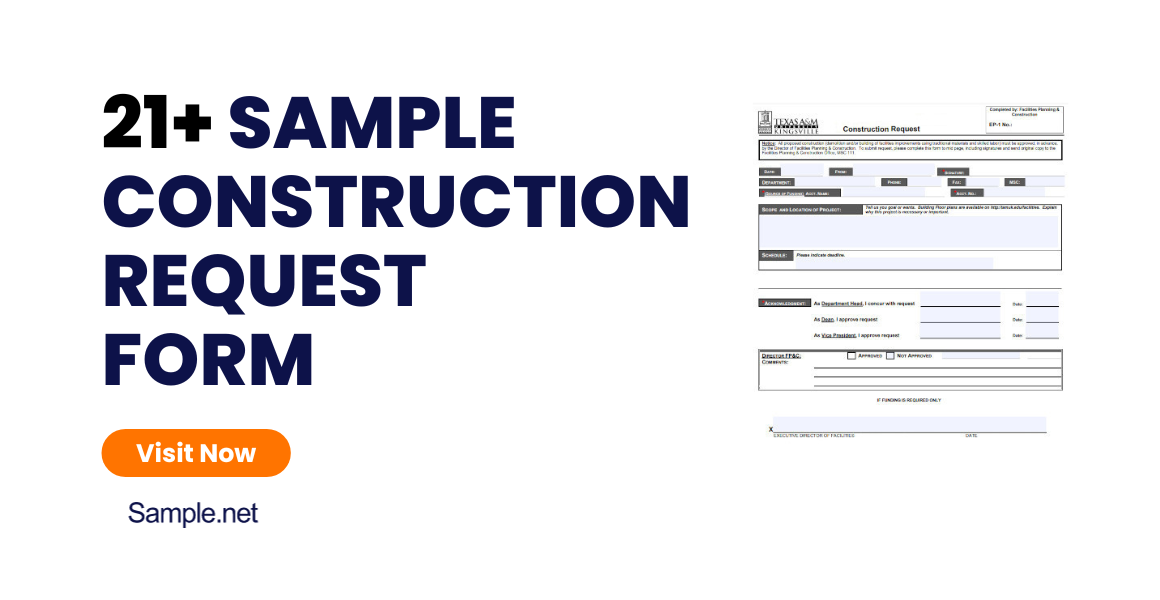Welcome to our Construction Request Form Your Gateway to Seamless Building Projects. Whether you're planning a residential renovation or a commercial construction venture, our user-friendly request form simplifies the…
continue reading20+ Sample Eviction Forms

Eviction Action Form
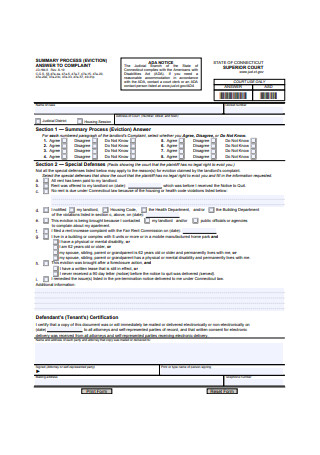
Sample Eviction Form
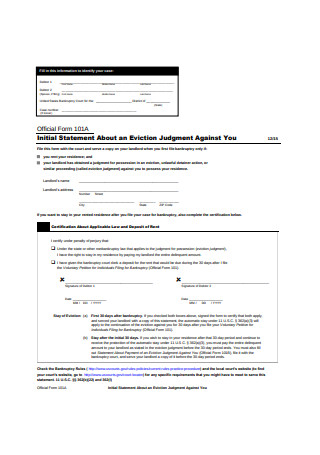
Official Eviction Form
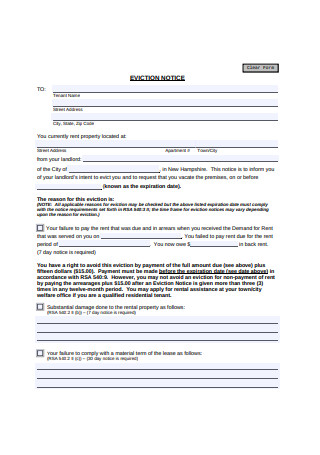
Eviction Notice Form
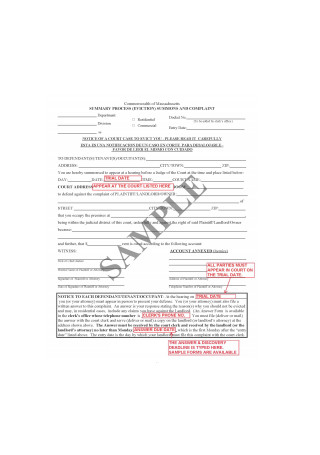
Eviction Complaint Form

Eviction Action Complaint Form

Application and Order of Eviction Form
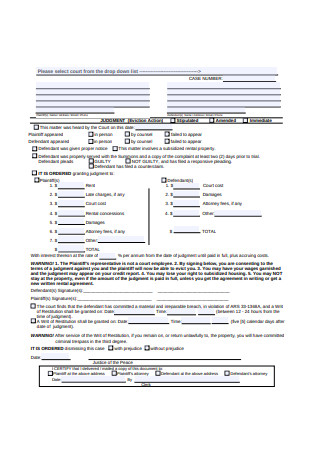
Judgement Eviction Action Form
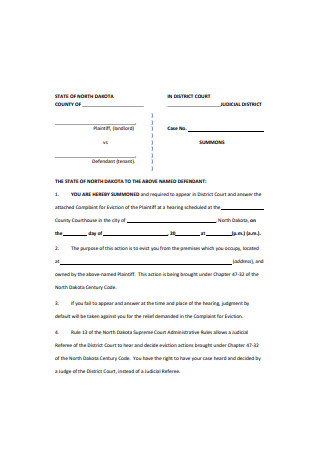
Simple Eviction Form

Complaint Form for Eviction
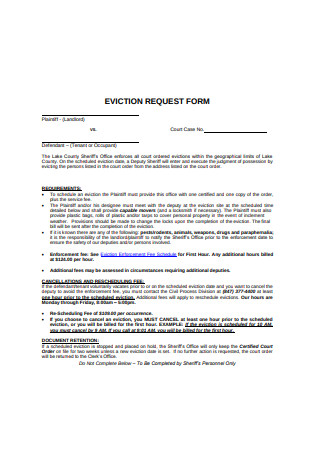
Eviction Request Form
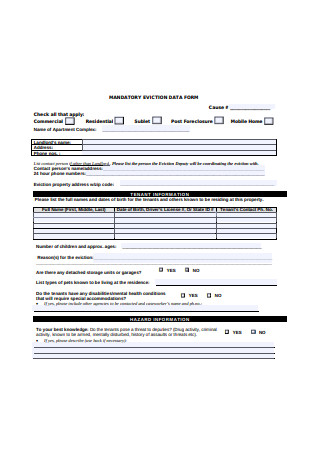
Mandatory Eviction Data Form
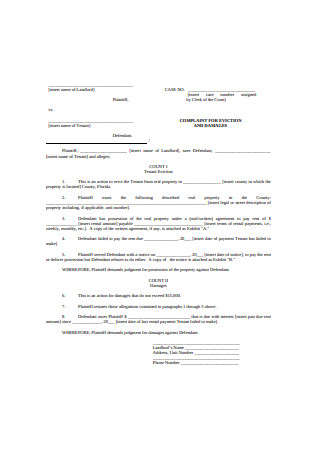
Complaint Form for Eviction and Damages
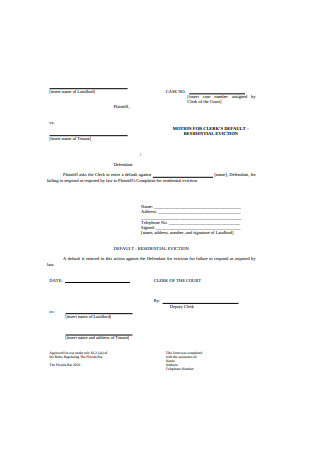
Residential Eviction Form

Eviction Form Example
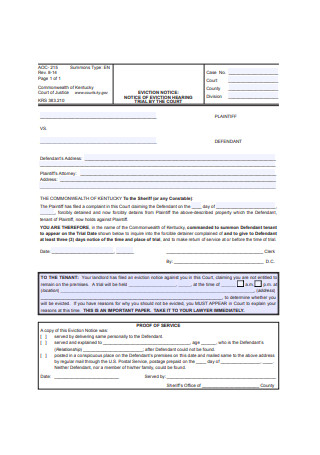
Eviction Notice Form Example
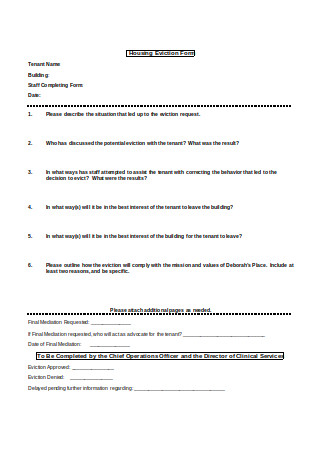
Housing Eviction Form

Eviction Information Form
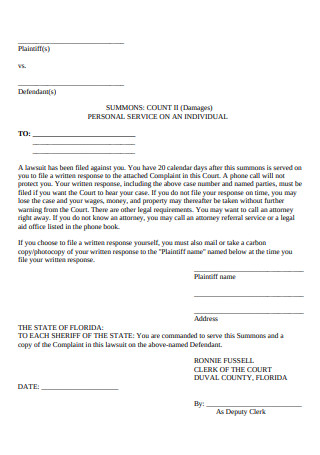
Eviction Form Format
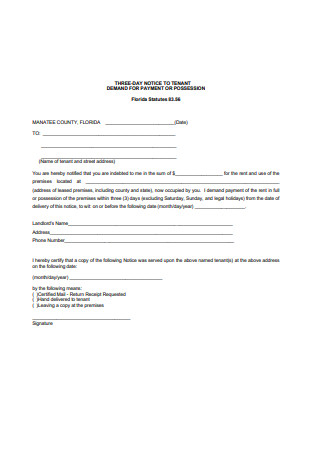
Format of Eviction Form
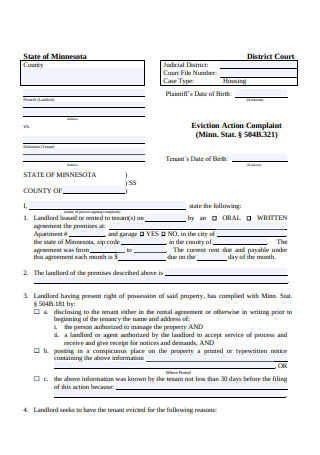
Eviction Complaint Form Sample
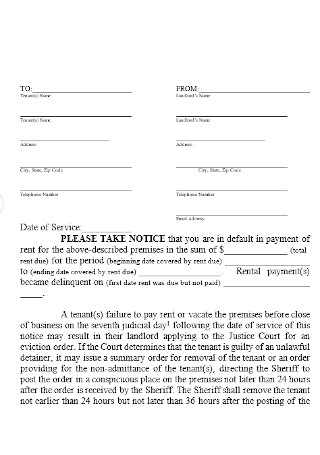
Seven Day Eviction Notice Form
download now
What Is an Eviction?
Eviction is the act of removing a tenant from a rental property in accordance with the agreement made with a landlord. The terms and conditions of the expulsion depend on what is reflected in the lease. Most evictions happen when the tenant fails to pay the rent or has developed a habit of paying late. But it’s also possible for a tenant to be evicted for other reasons depending on what is specified in the agreement. For instance, using the property to conduct criminal activities without the landlord’s knowledge is strictly against the terms of the lease. If the tenant does not move out after the initial notice, the property owner may file a court case to have them evicted.
“3.7 million renters nationwide have experienced an eviction in their lifetime as a renter.” (Source: CityLab)
“77.3 percent of eviction threats were due to the non-payment of rent. An additional 9.5 percent were due to other lease violations, while the remaining 13.2 percent of eviction threats were due to factors outside the renter’s control.” (Source: Apartment List)
Types of Evictions
Getting evicted from the house, apartment, or building that you reside in can be a demoralizing experience for anyone. This occurs when a tenant violates a term or condition stated in the lease agreement that he or she had signed prior to moving in. As a property owner, you do have the right to evict tenants who fail to conform to your arrangement. This can be done on the basis of nonpayment or late payment of rent, breaches of legal agreement, serious damage or illegal behavior within the property, or other possible terms. Listed below are the different types of evictions that may be filed.
How to Create an Eviction Notice
In order for the eviction to hold up in court, it must contain the necessary elements of a standard eviction form. The exact information to include in the document will vary depending on the reason for one’s eviction, along with the specific laws in your state that cover landlord-tenant affairs. While it’s best to consult a specialized attorney to determine the validity of the notice, for the meantime, it’s good to be aware of the general information that must be incorporated in the notice of eviction form.
Step 1: Determine the Violation Committed
What made you decide to evict the tenant? Have you taken all the appropriate measures to settle the problem? Is it too late to correct the issue so that no further legal actions need to be taken? If it’s the first time for the tenant to be late on their rental payment after rendering almost a year in the lease, you still have a chance to talk things through. The goal here is to allow the tenant to leave on their own accord without having to file a case in court. Considerations can be taken as long as they are not abused by the tenant. So if someone does not have the money to settle three months’ rent, from a business standpoint, the tenant must be evicted under the property owner’s best interest. Assess the situation and determine what specific reason the eviction should be filed for before moving forward to the next step of the process.
Step 2: Check Your State and Local Laws
Always review your state and local laws before finalizing the eviction. From the time for which a notice is provided to the tenant to the means of delivering the notice of eviction, policies may vary in different areas of practice. In most states, for instance, the law requires property owners to allow the tenant to vacate the property from thirty to ninety days from when the notice had been presented to them. Make sure you have gathered enough information to understand how these legal requirements work. You don’t have to be an expert in the matter, but it does pay to familiarize how the eviction laws in your county or state may affect the succeeding flow of events.
Furthermore, you’ll find it helpful to seek assistance from a legal expert in learning the laws particular to the state you are in.
Step 3: Write the Notice
If you have downloaded a form to create your eviction letter, then this step would be a breeze to get by. Every eviction form is different from the other as it includes information specific to the violation and state laws of the circumstance being faced. Using a business format, the form should contain the full names of the parties involved, the property address, the date the letter is written, the violation committed, and the contact details of the person the tenant can get in touch with should they have any questions they’d want to raise. The eviction form may also provide the options that the tenant has to resolve the situation before it is brought to court. Tenants should also be wary of the consequences that they may face if they fail to act accordingly.
The Dos and Don’ts of Tenant Evictions
Deciding to evict a tenant is a serious deed that should not be taken lightly. It’s sometimes the only choice you have to continue with operations and prevent further loss in profits. However, a strict procedure must be followed to have the tenant removed without crossing legal boundaries. One wrong move and you may end up with costly mistakes that could disrupt the eviction and delay the process. To rightfully evict a tenant from the property, take note of the following guidelines.
What to Do
1. Do speak with the tenant.
You’d want to settle things as amicably as possible. Chances are, you don’t know your tenants well enough to jump into conclusions. One way to avoid disagreements and maintain a good relationship is to talk to your tenant about the matter beforehand. Although you don’t want to make a tenant feel too comfortable with you, it won’t hurt to hear them out. You could even allow the tenant to propose a solution to address the problem or ensure a smooth eviction.
2. Do take the appropriate process.
The process of eviction would typically depend on the term of the tenancy that the tenant has broken. It’s important to file an eviction form that is applicable to the situation. Whether it’s a two-week notice or a two-month notice, you need to provide proof that the tenant had been notified about the eviction ahead of time. And if they fail to leave the property by the specified date, you do have the right to take legal action.
3. Do set a time frame.
There are different amounts of time that you can offer a tenant based on the violation they have caused. For example, causing serious and intentional damage to your property is a good enough reason to provide the tenant with a five-day notice to quit. A major offense like this would require the tenant to move out of the property within five business days, or further actions will be taken. But if you wish to offer the tenant a chance to fix their faults, a notice to cure is issued to give the tenant enough time to remedy the situation.
4. Do consider state and local differences.
The rules about eviction generally vary from state to state. Some local counties even have their own provisions to cater to the needs of their citizens. These laws provide the specifics on the types of violations that landlords can evict tenants for, the amount of time that must be given before the eviction is filed, and other important conditions to be noted. You must comply with these rules to avoid legal disputes that could lead to you having to pay a fine. So if you run a real estate business in different states, your eviction policies will likely differ in those locations.
5. Do attempt to resolve problems before taking legal action.
Taking matters to court can be stressful. You might have enough evidence to win, but imagine the amount of time and effort that goes into the process of filing the case and attending court hearings. If you can resolve the problem outside of court, then do what it takes to make it happen. Simple misunderstandings and neighborly disputes are pretty common in this line of business. So to avoid the inconvenience of court proceedings, make sure the eviction notice indicates a way for the tenant to avoid the eviction.
6. Do hire a lawyer for professional help.
Not many landlords are qualified to handle evictions on their own. Even the smallest mistakes could put you at a disadvantage in the situation, allowing the tenant’s lawyer to turn the tables on who’s at fault. The judge handling your case won’t be too keen about the idea of a person coming in with little to no knowledge of the subject either. You’ll likely mess up the case or prolong the process, causing even more problems down the road. Don’t make a fool of yourself in court—get an eviction attorney to help you out.
What Not to Do
1. Don’t neglect your obligations.
Don’t be too quick to call out a tenant. You need to make sure that you’ve managed to uphold your end of the rental agreement accordingly. Landlords are obliged to accommodate the needs of their residents in different ways, like in addressing maintenance issues and providing security for tenants. If you fail to perform your part of the agreement, it may be used against you in court to help favor the defendant.
2. Don’t get emotional.
Verbal spats between landlords and tenants occur more often than you think. When you find yourself in a heated argument, it’s easy to say something you know you’ll regret later. On some occasions, the things you say could be construed as evidence of housing discrimination. It doesn’t matter what the other party had said during the ordeal, as your words would always have a bigger impact on the case. If you happen to struggle with keeping an issue at bay, you might want to consider hiring a property manager to act as the buffer between you and a problem tenant.
3. Don’t threaten to shut off utilities.
It might be tempting to let your frustrations out by shutting off all utilities in the tenant’s unit. But as much as you want to do so, a constructive eviction like this is illegal in all fifty states. Forcing the tenant to leave will only put you in the losing side of the spectrum. Not only does it violate the rights of a resident, but it can also put you in hot water with state officials. The last thing you would want to do is to face the legal consequences of your petty actions.
4. Don’t change the locks.
Landlords usually have an extra key to access the rented property. But if you choose to enter the premises and change the lock without the tenant’s consent, you could be charged with a hefty fine for your actions. The tenant should be given enough time to move their belongings and vacate the area before this is done. If you don’t want to be penalized for committing such an act, it’s a good idea to inform the tenant of your plans upon notifying them about the eviction.
5. Don’t make things worse for the tenant.
Evicting a tenant who has failed to meet their dues on time can be complicated for most landlords. Low-income tenants can barely afford their everyday necessities, let alone their monthly rent in the city. Though you have no business in anyone’s personal life, the least you could do is understand the situation they are in. You have to be reasonable with the time you allocate for the eviction to help minimize the burden of moving. Additionally, it’s important to handle things professionally for everyone’s sake.
6. Don’t forget to review the notice.
Preparing an eviction notice form might be an easy task to complete, but you’d be surprised to know how often people still make mistakes. As simple as the form can be, the law is technical, and we must adhere to it. For an eviction case, you need to get the name, address, amount, and time right. Getting any of these details wrong will hinder the case from succeeding. Thus, be sure to check the data encoded in the form before proceeding to the next stage of the process.
If the tenant does not comply with your notice to vacate, a formal eviction may follow. Local law enforcement may also be called to assist you in moving a tenant out. Eviction forms can be useful when you need to hasten the process while still meeting legal requirements, or even when you have a ton of properties to manage and more than a dozen tenants to deal with at the same time. Feel free to download a form template for your convenience.

